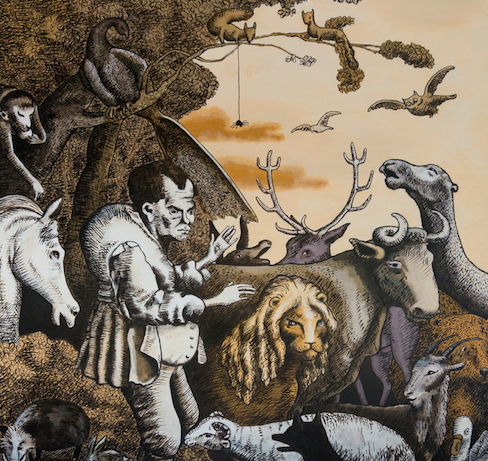En el bosque mis días solía pasar
salvaje y cruel
seguro en mi soledad
tu voz me hizo ver
tu luz me alejó del mal
Serú Girán, San Francisco y el lobo
Se afirma con frecuencia que una de las características que diferencian al hombre de los animales (o más exactamente a la especie humana de los otros animales) es el lenguaje. Aunque sería más apropiado decir que usamos un lenguaje distinto al de ellos; en ese sentido y visto desde la perspectiva de una herramienta que permite la comunicación efectiva entre los miembros de una misma especie, un perro podría decir: «lo que nos diferencia de los humanos no es la capacidad de hablar entre nosotros, sino que poseemos un lenguaje diferente» En términos de lenguaje, ¿Cual es la diferencia, entonces, entre un delfín y un águila, un perro y un humano, un peruano y un tibetano?
Muchos de nosotros hablamos con los animales, y ellos con nosotros. Nos entendemos, nos hemos entrenado mutuamente en el ejercicio cotidiano de gestos y actitudes, pero también de palabras y gritos, de gemidos y aullidos, gruñidos, maullidos, graznidos, ladridos, balidos, cloqueos y barritos. También en lenguajes de miradas. ¿Porqué nos parecería fuera de lo común que alguien hable con los animales? Usando técnicas de representación cercanas al arte popular y haciendo referencias al kitsch (que podría definirse como «el gusto de los otros»), a las estéticas vernáculas y al gusto de la clase media, Juan Mejía ha realizado una galería de retratos de personajes célebres y no célebres cuya característica común es su capacidad de comunicarse con los animales.
Las referencias van desde el mito y la religión a la ciencia, del arte conceptual a la cultura de masas: Noé y Aquaman, Konrad Lorenz y el Dr. Doolittle, Joseph Beuys y Durero comparten la escena en igualdad de condiciones en este particular Olimpo. Ellos hablan con los animales y los animales con ellos; los demás (es decir, nosotros), no comprendemos el lenguaje que ellos parecen compartir, y los miramos, con envidia, desde la distancia de nuestras limitadas capacidades comunicativas.
El arte es también un lenguaje cuyos códigos no son necesariamente compartidos a través de las diferentes culturas. Algunos hablan «arte» de manera fluida, otros no logran comprenderlo. ¿Existe posibilidad de que los unos se comuniquen con los otros? ¿Hay un lenguaje universal -o al menos una lengua medianamente compartida- en el ámbito del arte? Milan Kundera afirmaba que «el sentimiento que despierta el kitsch debe poder ser compartido por gran cantidad de gente. Por eso el kitsch no puede basarse en una situación inhabitual, sino en imágenes básicas que deben grabarse en la memoria de la gente». Juan Mejía pareciera querer decir que en la distancia aparentemente insalvable entre el lenguaje del arte «culto» y la cultura popular hay sin duda muchos puntos de encuentro.
José Roca
El día de la inauguración se convidó a que el público asistiera con sus mascotas, se realizó una sesión fotográfica, cuyo resultado se presentó paralelo a la exposición.
—
In the woods my days flow usually
wild and cruel
safe in my loneliness
your voice made me see
your light rescued me from the evil.
Serú Girán, St. Franciscus and the wolf
It is often said that one of the characteristics that differentiate a man from an animal (or more specific: the human species from animals) is the language. Although, it would be more suitable to say that we use a different language than animals. In this sense – through the perspective with a tool, that permit the effective comunication between members of the same species – a dog could say “what sepatates us from a human beings is not the ability to speak with each other but that we have different languages.”
So, in language terms, what is the difference between a dolphin and an eagle, a dog and a human, a Peruvian and a Tibetian?
Many of us speak with animals and they with us. We understand each other, have trained us mutually in the daily exercises of gestures and attitudes; but also, of words and screems, of goans and howls, croakings, caterwaulings, barkings, bleating, clucking and trompeting; as well as in eye language.
So, why seems it strange to us when someone speaks with animals?
Using representation techniques near to the folk art and referring to kitsch (that might be defined as the “taste of others”), to verancular estetics and the taste of the middle class, Juan Mejía has realized a gallery full of portraits of famous and unknown personalities whose comun characteristics are to communicate with animals.
The references go from the myth and the religion to the science, from the conceptional art to the pop cultur: Noé and Aquaman, Konrad Lorenz and Dr. Doolittle, Joseph Beuys and Durero share the scene on equal parts in this particular Olympus. They speak with the animals and the animals with them. The others (that means: we) we don´t understand the language that they seem to share. And we look at them jealousy from the distance of our limited comunicative abilities.
Art is also a language, which codes are not necesarry shared through the different cultures. Some people speak “Art” fluenty, others do not understand it. Does the possibility exist, that these ones could communicate with the others? Is there a universal language- or at least a directly shared language – in the area of art? Milan Kundera affirmed that “the feeling that wakes the kitsch up has to be able to be shared with a large number of people. That´s why the kitsch cannot be based on a unusual situation.” Juan Mejía seems to meen that in the apparently insolvable distance between the language of “cultural” art and the pop culture are many equal points.
José Roca
At the opening day, a photo session with the visiters and their pets was realized.
